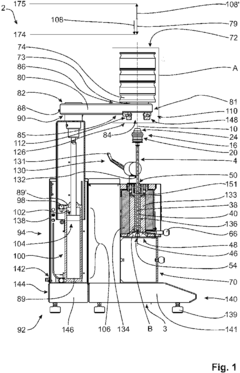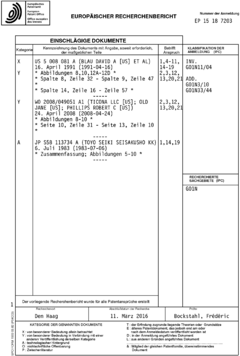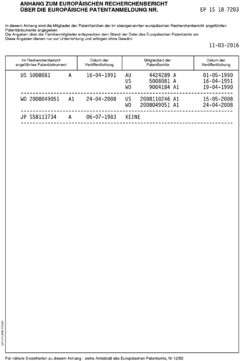Improving The Flow Efficiency Of Check Valves For High Viscosity Fluids
Technology Background And Goals
Addressing these issues is crucial for optimizing fluid handling systems across various industries, including oil and gas, chemical processing, and manufacturing.
Check Valve Market Demand Analysis
- High Viscosity Fluid Applications
High viscosity fluids are widely used in various industries, including oil and gas, chemical processing, food and beverage, and pharmaceuticals. These fluids pose challenges in terms of flow efficiency due to their thick and sticky nature. - Market Demand Drivers
The demand for efficient check valves for high viscosity fluids is driven by the need for reliable and cost-effective fluid handling systems, energy efficiency, and compliance with environmental regulations. - Market Size and Growth
The global market for check valves for high viscosity fluids is expected to grow steadily, driven by the expansion of industries that rely on these fluids and the increasing emphasis on process optimization and energy efficiency. - Regional Market Dynamics
The Asia-Pacific region is anticipated to be a significant market for check valves for high viscosity fluids, driven by the rapid industrialization and growth of the chemical and oil and gas sectors in countries like China and India.
Technology Status And Challenges
- Valve Design Limitations
Current check valve designs face challenges in handling high-viscosity fluids, leading to reduced flow efficiency and increased pressure drop. - Material Compatibility
High-viscosity fluids often have unique chemical compositions that may not be compatible with standard valve materials, causing corrosion or degradation. - Clogging and Fouling
The tendency of high-viscosity fluids to accumulate and solidify within the valve body can lead to clogging and fouling, impeding valve operation. - Sealing Effectiveness
Maintaining an effective seal against backflow becomes more challenging with high-viscosity fluids due to their unique flow characteristics and potential for leakage. - Maintenance and Cleaning
Valves handling high-viscosity fluids often require more frequent maintenance and cleaning due to the buildup of residues and potential for blockages.
Current Technical Solutions
01 Streamlined Designs
Incorporating features like optimized valve bodies, geometries, and low-friction components to facilitate smoother flow and reduce turbulence.- Optimized Valve Design: Enhancing flow efficiency through optimized valve geometry, seat configuration, and streamlined flow paths to minimize turbulence and pressure drop.
- Low-Friction Materials: Utilizing low-friction materials and coatings with smooth surfaces to reduce flow resistance and turbulence, improving overall flow efficiency.
- Enhanced Flow Capacity: Employing configurations like parallel valve arrangements, multiple ports, or larger openings to increase flow capacity and reduce restrictions.
- Minimized Flow Disruptions: Designing mechanisms for smooth valve operation, guided movement, and streamlined elements to minimize flow disturbances and turbulence.
- Optimized System Integration: Strategic valve placement, system layout, and consideration of upstream/downstream conditions to optimize flow efficiency in larger systems.
02 Low-Friction Materials
Utilizing low-friction materials and coatings to minimize surface roughness and flow resistance, improving overall efficiency.Expand Specific Solutions03 Optimized Configurations
Designing valve configurations like in-line, angle, or swing types to optimize flow paths and minimize turbulence for specific applications.Expand Specific Solutions04 Flow Area Optimization
Proper sizing and optimization of the flow area through the valve to reduce pressure drop and flow restrictions.Expand Specific Solutions05 Flow Control Mechanisms
Incorporating adjustable flow restrictors, bypass channels, or regulation mechanisms to optimize efficiency under varying flow conditions.Expand Specific Solutions
Technology Main Player Analysis
Halliburton Energy Services, Inc.
Cameron International Corp.
Key Technology Interpretation
- The scheme also incorporates the use of targeting ligands, such as antibodies or aptamers, to enhance the specific accumulation of the drug at the target site, thereby increasing the therapeutic efficacy and reducing side effects.
- The patent scheme aims to address the challenges faced in conventional drug delivery systems, such as low bioavailability, non-specific biodistribution, and off-target effects, by providing a more precise and controlled drug delivery system.
Technology Economic Analysis
The primary economic benefit lies in the potential reduction of operational costs for industries handling high-viscosity fluids. Improved flow efficiency can lead to lower energy consumption, reduced maintenance requirements, and increased lifespan for equipment and systems. These cost savings can contribute significantly to the overall profitability of the operations.
In addition to cost savings, enhanced flow efficiency may enable new applications or expand existing markets for high-viscosity fluid handling. This could open up revenue streams and create opportunities for market expansion, further driving economic growth and competitiveness for companies adopting this technology.
However, it is crucial to consider the initial investment required to develop, manufacture, and implement these improved check valves. This includes research and development costs, capital expenditure for new equipment or retrofitting existing systems, and potential training or personnel expenses. A thorough cost-benefit analysis should be conducted to determine the return on investment and the projected payback period.
Furthermore, the economic analysis should consider the potential impact on supply chains, logistics, and distribution networks. Improvements in flow efficiency may necessitate adjustments to existing infrastructure or transportation methods, which could introduce additional costs or create new efficiencies.
Lastly, the analysis should explore potential market demand, competition, and pricing strategies. Understanding the willingness of customers to adopt and pay for improved flow efficiency solutions is crucial for assessing the economic viability and potential market share capture.
Technology Policy And Regulatory Impact
Regulatory impact assessment is a crucial step in the technology development process, aiming to ensure compliance with relevant laws, regulations, and industry standards. In the context of improving the flow efficiency of check valves for high-viscosity fluids, several regulatory aspects need to be considered:
The design and manufacturing of check valves must adhere to industry-specific regulations and guidelines. For instance, in the oil and gas sector, the American Petroleum Institute (API) sets standards for valve performance, materials, and testing procedures. Compliance with these standards is essential for ensuring the safety and reliability of check valves used in harsh environments.
Additionally, environmental regulations may come into play, particularly if the high-viscosity fluids being handled are hazardous or have the potential for environmental contamination. Relevant regulations, such as the Resource Conservation and Recovery Act (RCRA) or the Clean Water Act, may impose restrictions on the handling, storage, and disposal of these fluids, as well as the materials used in the valves themselves.
From a health and safety perspective, regulations like the Occupational Safety and Health Administration (OSHA) standards may apply to the design and operation of check valves. These regulations aim to protect workers from potential hazards, such as exposure to hazardous substances, excessive noise levels, or mechanical risks associated with valve failure or maintenance.
Depending on the industry and application, additional regulatory frameworks may need to be considered. For instance, in the pharmaceutical or food processing industries, check valves must comply with stringent hygiene and cleanliness requirements to prevent contamination and ensure product safety.
It is crucial to conduct a comprehensive regulatory impact assessment early in the development process. This assessment should identify all applicable regulations, standards, and guidelines, and ensure that the proposed solutions for improving flow efficiency are fully compliant. Failure to address regulatory requirements can lead to legal issues, fines, or even product recalls, undermining the viability and market acceptance of the improved check valve design.


